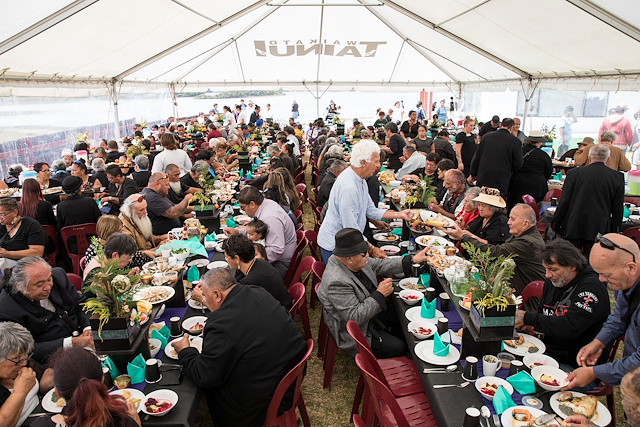Ngāti Hikairo in Kawhia have traversed a long journey to complete the build of their new wharekai and kāuta at Waipapa Marae. The new wharekai will provide the space to feed the people that visit their marae each year.
Published: Thursday, 30 May 2019 | Rāpare, 30 Haratua, 2019

The new wharekai was opened by Kingi Tuheitia Pōtatau Te Wherowhero VII. The building was named ‘Te Maru o Hikairo’ by the King’s eldest son, Whatumoana Paki and designed to meet wishes of the late Māori Queen, Te Arikinui Dame Te Atairangikaahu, who wanted ‘a room with a view’ of the Kawhia Harbour.
Features of the new design include a glass window of panels facing the harbour to capture the view and physically link the wharekai to the Kawhia Harbour.
Feed the masses
When the wharekai was initially opened in 1955 it was set up to only cater to 120 people in one sitting, which often meant more than one sitting per meal at bigger hui like the annual poukai, to feed the masses.
A challenge for Waipapa Marae has been getting enough hands in the kitchen to feed the people.
However that is all about to change.
The new dining room is expected to feed twice as many people as the previous wharenui in one sitting, with half the number of ringawera (kitchen workers) required to help feed guests during important annual events such as Poukai.
It all starts with a plan
To help get the new wharekai project off the ground the iwi scoped a new plan for the wharekai, with an aim to build a wharekai that meets the needs of the people.
The Waipapa Marae Development Plan is a key element that underpins the new wharekai says Project Manager Kruger Wetere.
“We had a clear vision for what we wanted to achieve to future-proof the wharekai to meet the needs of our people, including promoting and supporting Ngāti Hikairo traditions such as the annual poukai and enabling healthier menus to be prepared at the Marae.”
Kruger shares taking a broader approach to plan for the sustainable future of the Marae, that goes beyond replacing marae buildings, and getting wider support from their people to make it all happen has been positive.
A guide to assist in developing the marae development plan can be found in te reo Māori and in English on the Te Puni Kōkiri website.
“Using this guide to help develop our own marae development plan was particularly helpful,” says Kruger.
“In addition, we drew on the expertise and knowledge available within our own whānau and hapū as well as industry expertise to help formulate our plan.”
Kruger’s advice for other marae when pulling their own marae development plans would be to reach out and ask for help.
“It will take a lot of time if you started from scratch with pulling your own documentation together. Don’t reinvent the wheel. There will be others who have done this journey before so reach out and ask them to share what they have learnt to help get your marae plans off the ground.”

The people of Ngāti Hikairo opened their new wharekai at Waipapa Marae. Photo by Te Rawhitiroa Bosch
Taking a holistic look at marae wellbeing
Oranga Marae is more than just investing in marae buildings sharing. The wellbeing of the Marae has much to do with the whare as it does with whānau.
Oranga Marae invests in both the physical development as well as cultural development of the marae.
In addition to repairing whare and capital works Oranga Marae can support descendants to learn about tikanga and kawa or upskill in traditional practices, such as whaikōrero or karanga.
About Oranga Marae
Established only in May 2018, Oranga Marae is a co-investment initiative of Te Puni Kōkiri and the Department of Internal Affairs. Whānau, hapū and iwi can access funds through one system, with support from advisors where needed.
Waipapa Marae was the first initiative out of the Oranga Marae fund.
Oranga Marae funding, jointly provided by Te Puni Kōkiri and the Lottery Grants Board, is making it all possible. Te Puni Kōkiri has contributed $250,000 and the Lottery Grants Board funding, administered by the Department of Internal Affairs has contributed $475,000 to the cost of Waipapa Marae.
Oranga Marae replaces the Lottery Marae Heritage and Facilities Fund, which has permanently closed.